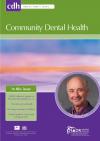Community Dental Health

- Cover Date:
- June 2016
- Print ISSN:
- 0265 539X
- Vol:
- 33
- Issue:
- 2
Association between child caries and maternal health-related behaviours
Objective: To examine the association between 2-6 year-olds’ caries experience and selected maternal oral and general health-related behaviours in an American sample. Methods: Data pertaining to 917 child/mother pairs was from the Third National Health and Nutrition Examination Survey 1988-1994. Child caries experience was indicated by the presence of one or more decayed or ï¬lled tooth. Data on maternal smoking, frequency of dental visits, consumption of unhealthy food and oral hygiene was linked to children data using the natality ï¬le. An aggregate behavioural variable was created. Logistic Regression models were used to assess the association between child caries experience and maternal behaviours adjusting for child’s age, gender, ethnicity, dental visits and mother’s age, education and poverty-income ratio. Results: All four maternal behaviours were signiï¬cantly associated with child caries in fully adjusted models with
odds ratios 1.42 (95%CI:1.01,2.01) for current smokers versus non-smokers, 1.01 (95%CI:1.01,1.02) for frequent consumption of unhealthy food, 1.63 (95%CI:1.15,2.31) for infrequent dental visits, and 2.49 (95%CI:1.44,4.29) for poor oral hygiene. Conclusions: The results indicate that children’s caries experience is related to a number of maternal behaviours including behaviours not directly related to caries such as smoking. Maternal oral and general health-related behaviours should be incorporated in children’s caries risk assessment and in behaviour changing interventions provided in dental practice to improve children’s oral health.
Key words: child, dental caries, maternal, behavior, American
doi:10.1922/CDH_3801Phillips05
- Article Price
- £15.00
- Institution Article Price
- £
- Page Start
- 133
- Page End
- 137
- Authors
- M. Phillips, E. Masterson, W. Sabbah
Articles from this issue
- Title
- Pg. Start
- Pg. End
- Child oral health in migrant families: A cross-sectional study of caries in 1-4 year old children from migrant backgrounds residing in Melbourne, Australia
- 100
- 106
- Feasibility, utility and impact of a national dental epidemiological survey of three-year-old children in England 2013
- 116
- 120
- A bi-level intervention to improve oral hygiene of older and disabled adults in low-income housing: results of a pilot study
- 127
- 132
- Caries and costs: an evaluation of a school-based fluoride varnish programme for adolescents in a Swedish region
- 138
- 144
- Examiner reliability in fluorosis scoring: a comparison of photographic and clinical methods
- 145
- 150
- Do ‘poor areas’ get the services they deserve? The role of dental services in structural inequalities in oral health
- 164
- 167
